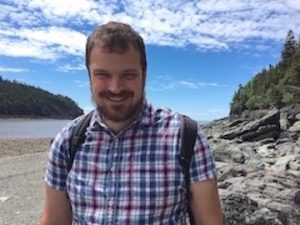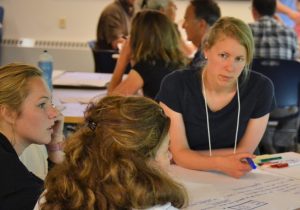Home Work
Good to his word, Aaron Strong returned to Maine to tackle sustainability challenges
After completing his Ph.D. in environment and resources at Stanford with an eye trained on the human dimensions of sustainability challenges, Aaron Strong, the son of two Bates College professors and now a UMaine School of Marine Sciences assistant professor of marine policy, fulfilled a promise and came home to get down to work.

“It feels really good to have come back home to focus on big sustainability challenges at the scale at which people make decisions in their communities,” says Strong.
Another key aspect of his returning home to Maine was the opportunity to work closely with UMaine’s Mitchell Center for Sustainability Solutions.
“Had the Mitchell Center not been here I would not have been as attracted to the position,” he notes. “Not necessarily because of any one thing the center does, but its existence as a locus and focusing agent to bring people together from around campus to talk and share information about these important issues.”
Issues like constructing decision support tools. “So that, for example, we can work with people in coastal communities to actually provide them with information on climate change that is functionally useful to them in their daily lives.”
To wit, Strong’s very first Mitchell Center-funded project looks at ocean and coastal acidification in Maine. The project tackles a problem that presents a unique set of sustainability challenges along Maine’s coast, threatening the livelihoods of coastal communities through its current and future impacts on commercially important species such as oysters, clams and lobsters, and the delivery of ecosystem services.
Ocean and coastal acidification is primarily driven by global carbon dioxide emissions caused by human activity. However, recent evidence has made it clear that local-scale factors are also important: low alkalinity river runoff, excessive nutrients in water bodies, and the intrusion of deep ocean waters can exacerbate localized coastal acidification.
Says Strong, “And Maine is particularly vulnerable because of our position in the Gulf of Maine, which has a lot of freshwater inflow and is very cold, and both of those physical factors mean we’re already close to the edge compared to other locations dealing with ocean acidification.” He adds, “And from the social perspective, we have communities that are heavily reliant on fisheries like commercially important shellfish fisheries—and shellfish are particularly susceptible to ocean acidification.”
There are no easy comprehensive policy or social solutions with respect to ocean acidification, Strong points out, “Yet we know that addressing ocean and coastal acidification—through mitigation, adaptation or remediation activities—at local scales is possible.”
But to do so requires sustained, coordinated activities among citizens, scientists, non-profit organizations, industry, and regulatory agencies. Such coordinated activities can help catalyze the creation of a “solutions-oriented community.”
The new project Strong is leading with a handful of co-investigators, titled “Ocean and Coastal Acidification in Maine: Expanding Community Resilience Through Citizen Science, Outreach, and Education,” will establish standardized coastal acidification monitoring efforts by such a solutions-oriented community—with volunteer citizen scientists at its core.
The effort builds on Maine having taken a lead role on the issue. In 2014, Maine became only the second state in the U.S. (Washington State was first) to create an ocean acidification commission. However, unlike Washington, the state legislature in Maine did not create a funded council to carry out the work, which in turn led to the formation of the Maine Ocean and Coastal Acidification Partnership (MOCA)—a volunteer network of scientists, educators and conservation organizations seeking to implement the Maine study commission’s recommendations.

Kicking off Strong’s project in mid-June this year, affiliates of MOCA met together with representatives from the U.S. Environmental Protection Agency (which recently created the first guidelines for doing coastal and ocean acidification monitoring), the National Oceanic and Atmospheric Administration and industry stakeholders at UMaine’s Darling Marine Center for a planning meeting to advance best practices in ocean and coastal acidification monitoring. The workshop focused on next steps for monitoring collaborations and new partnerships throughout the region—with an emphasis on building capacity from the ground up.
“For a problem like ocean acidification, monitoring is the key,” says Strong, “and here’s why. Say you run an oyster hatchery and things aren’t quite as productive as you’d hoped. If you aren’t measuring and monitoring pH levels and other elements of carbon chemistry in the water relevant to baby oysters, you’re missing out on an opportunity to take steps to address the problem.” Strong adds, “If we are ever to put ourselves in a position to adapt to our changing environment, we can’t manage what we can’t measure.”
Coordinated measurements will provide critical information where in Maine’s coastal and ocean waters acidification is it happening, where is it likely to be the worst, and what can be done about it. “And that,” Strong says, “requires building connections between facilities that have the level of equipment necessary to make certain kinds of measurements and our robust network of volunteer water quality monitors.”
By David Sims
